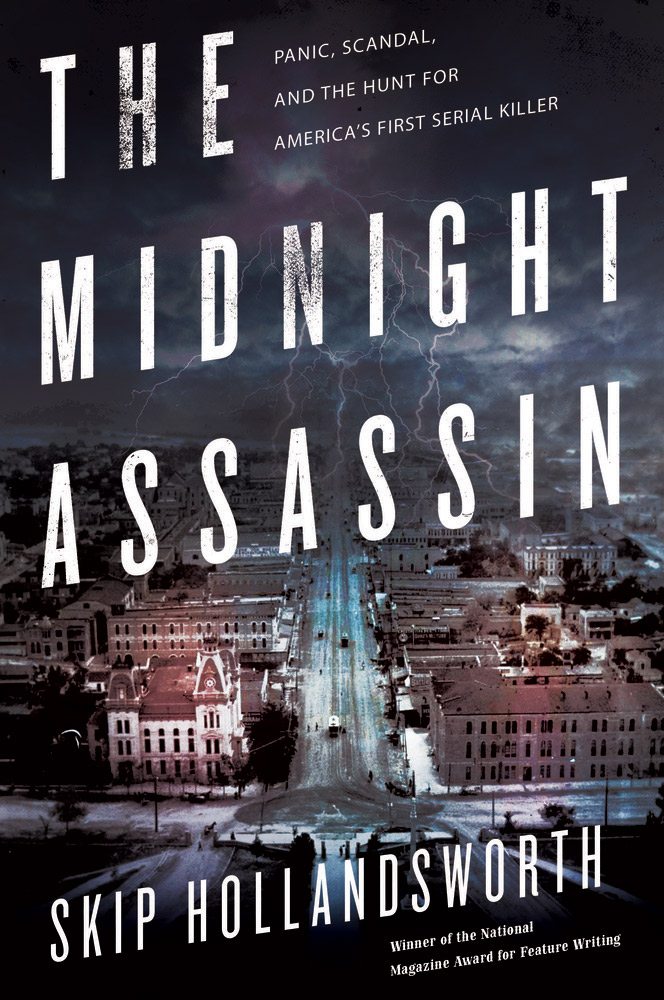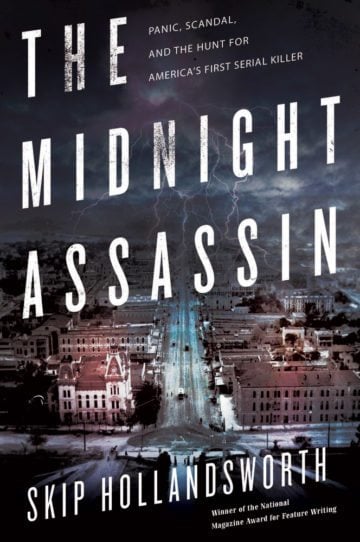
‘Midnight Assassin,’ A Century-Old Mystery with Modern Lessons on Race, Police, Power
The black community affected by Texas’ first serial killer is filtered through a white lens in 'The Midnight Assassin.'

A version of this story ran in the June 2016 issue.

by Skip Hollandsworth
HENRY HOLT
321 pages; $30
All good crime reporters have stories that haunt them well after the final fact check. Loose ends, niggling details, witness statements that never quite lined up just right. It only makes sense that Texas Monthly’s Skip Hollandsworth, one of Texas’ finest journalists and preeminent crime writers, has one of those stories, maybe even the biggest one: a nearly 130-year-old unsolved string of murders involving scandal at the highest levels of Texas government, enraging and sometimes comical police ineptitude, high-society women and, at the heart of it all, servant girls. Hollandsworth first wrote about the murders for Texas Monthly back in 2000, packing his true-crime feature with the grisly details: seven women and one man beaten and slaughtered in the most appalling fashion in 1884 and 1885 Austin. In his new book, The Midnight Assassin, the dogged researcher has an opportunity to stretch his legs.
The crimes are popularly known as the “Servant Girl Murders,” committed by a still-unidentified assailant who in the contemporary press was called the “Texas Jekyll” and the “Texas Frankenstein,” among other colorful and terrifying descriptors. Five black women, all domestic servants, were attacked at night in their homes, the backyard quarters of their employers. One man, recruited to keep watch amid the murders, also fell victim to the killer. The deaths of two white women, both killed on Christmas Eve, 1885, concluded — as far as we know — the spree.
Hollandsworth is undoubtedly the foremost expert on the Servant Girl Murders, and he’s spent nigh on 20 years contemplating a terrible, sensational case that very few people, even within Austin and Texas, have much bothered with. This despite the fact that the crimes are likely the work of America’s first serial killer, and predate Jack the Ripper by three years.
Texas is not known, as Britain is, for its famous and brutal real-life serial killer. It was charming church choir man Bernie Tiede whom Richard Linklater, the undisputed Almighty of Austin film, chose to profile in the film Bernie (Hollandsworth co-wrote the screenplay). When we talk about Texas murder narratives, we like our killers to be as kooky as they are creepy — think Blood Simple and No Country for Old Men. Even The Texas Chainsaw Massacre, camp through and through, was a Texified take on a series of murders that actually took place in Wisconsin. The charm, or perhaps horror, was all in Texas the idea — not Texas the reality.
The latter is where The Midnight Assassin sings. The contemporary experience and handling of the Servant Girl Murders is uniquely Austinesque, the products of a city and state struggling for affirmation as a forward-thinking, progressive outpost in a late-19th century America already pining nostalgically for the Wild West and, in many ways, the Antebellum South. And yet the “Servant Girl Annihilator,” as he was dubbed by then-Austin resident William Sydney Porter, better known as O. Henry, rampaged unapprehended for 13 months for all kinds of reasons, many of them patently regressive: outright racism, the city’s lackluster infrastructure and attendant failure of policing thereof, ineptitude at all levels of state and local leadership, and a basic dearth of anything like what we would today recognize as forensic or even investigative policing.
It makes for a fascinating, maddening read for those of us who can’t help but figuratively flail, impotent and raging, as we turn the page to find misstep after misstep: racist assumptions about gangs of black men out for blood, the hiring of the wrong Pinkerton private detective agency, the trampling of crime scenes by scores of reporters and cops. To modern eyes, the relentless failures reported by Hollandsworth seem unfathomable.
Hollandsworth is undoubtedly the foremost expert on the Servant Girl Murders, and he’s spent nigh on 20 years contemplating a terrible, sensational case that very few people, even within Austin and Texas, have much bothered with.
Black Austinites must have lived in fear of being murdered or wrongly apprehended for the crimes by a racist establishment and white populace that Hollandsworth describes as ready to believe the worst about their black neighbors. But instead of finding a way for black Austinites to speak, the book centers whiteness — from its focus on state and local leaders and their foibles and scandals to the two murder victims about whom we know the most, Eula Phillips and Susan Hancock, wealthy white women.
I put this critique to Hollandsworth himself.
“The book could have been blacker,” he agreed, noting that he’s got hundreds of pages of research on black life in 19th century Austin that peppers, rather than pervades, his narrative. In early drafts, he said, he got lost in the story of the “richness of black life” in Austin, and was ultimately stymied by length when it came to producing a historical true-crime thriller with a city, rather than a criminal or cop, as main character.
Hollandsworth does write about servant women fleeing Austin or carrying hoodoo amulets for protection, and details a public demonstration from black civic leaders demanding the city do better to end the midnight assassin’s reign of terror. But I dearly wish he’d included more of this contextual material to round out that main character — the city itself.
In setting the tone for his book that actively courts a wide audience, Hollandsworth had an opportunity to prioritize the identities and experiences of Austin’s black community, people who, but for these terrible crimes, might never have entered the historical record. That itself is tragic and reprehensible — but it also reflects an unusual point of narrative intervention. In the swirl of fact and myth about Jack the Ripper, he is the bogeyman fulcrum, his story and his motivations far more central than the lives of the marginalized group — white British sex workers — he targeted. Generally, when sex workers turn up in popular culture and conversation, they’re punch lines, objects of prurient interest or legislative disdain, very rarely portrayed as who they are, or can be: agent participants in a capitalist economy that benefits from their marginalization and, often, their dehumanization.
And so it’s notable that The Midnight Assassin was chosen as a title, as opposed to a variation on the more widely known Servant Girl Murders. “Servant girl” doesn’t automatically call to mind blackness, but the servant girls, the majority of the victims in this case, were black. The Midnight Assassin is a deliberate choice that to some degree obfuscates the true nature of an atrocity mostly committed against a very particular marginalized population — black women — and for which another very particular marginalized population — black men — was assumed to be responsible.
More than a century later, people of color are still struggling to have the violence they endure, both institutionally and literally, taken seriously. “Black lives matter” is twisted into the cloyingly pedantic “All lives matter,” or even turned around entirely, through “Blue lives matter,” to elevate the perpetrators of police violence. Not just in Austin or in Texas but across the nation, women of color, especially transgender women of color, receive little attention when they are gunned down, run over or beaten. In contrast, the deaths of attractive white women, awarded racial respectability by default, are investigated and analyzed at length — think Nancy Grace’s frothy prime-time true-crime show, or the disappearance of Natalee Holloway and the murder of Laci Peterson.
There’s something disappointing, then, in taking the servant girls out of the Servant Girl Murders, particularly in a book that, as Hollandsworth himself bemoaned to me, has no third act. We don’t know who the midnight assassin was, though Hollandsworth told me he kicked off his research thinking, perhaps foolishly, in hindsight, that he could find the long-lost evidence that would solve the crime.
But what if our stories about murder, about serial killing and sexual assault and racist violence, asked bigger questions, not about whodunit but about why they dun it and who they targeted?
Hollandsworth leaves much of that intellectual work up to the reader. He offers no suggestions as to the identity of the killer, though the media produced about the murders thus far often pins the crime on a particular suspect, name-checked but once in The Midnight Assassin. (I won’t spoil it for you if you want to go down a Google rabbit hole — and you will — after finishing the book.)
The Midnight Assassin can certainly be read as a smarter-than-average true-crime thriller, impeccably reported and researched, a kind of cloudy-day beach read for the Texana enthusiast. But it takes only a little reading between the lines to find troubling parallels to today’s conversations about race, crime and policing. I wish Hollandsworth had given those of us who’d like to take on the latter task a little more to chew on.


